Back to Product Category
FIXED STEEL LADDERS
SERIES WLFS & WLFC |
WALK-THRU
AND STANDARD |
|
|
|
|
|
|
|
|
 |
|
•
Side rail 2 - 1/2” x 3/8” flat bar
• Solid round 3/4” rungs
• 12” spacing between rungs
• 18” ladder width
• 42” guardrails on walk-thru models
• Powder-Coat Gray or Safety Yellow Finish (WLFC)
(WLFS comes only in Safety Yellow Finish)
• Complies with applicable OSHA & ANSI standards |
 |
|
|
|
|
|
|
|
|
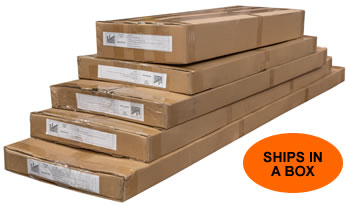 |
|
|
|
|
|
|
|
|
|
Fixed ladders
are shipped in a box. Standard ladder
sections, in rung lengths from 4-7 steps, are combined
to form a finished kit. A boxed walk-thru section can
be added as well. Boxed ladders provide huge freight
savings! |
|
|
|
|
|
|
|
WLFS
Yellow Only |
|
|
|
|
WLFC
Yellow or Gray |
|
NOTE:
• Ladder drawings are available by clicking Model #.
• See Fixed Ladder Requirements at bottom of page.
• Ladder mounting table is shown below price tables.
• Optional ladder door guard is listed below price tables. |
|
|
|
|
|
|
 |
|
Order
Online, by Phone, or by E-Mail |
|
|
|
~ Add
items to your online shopping cart ~
Click the Price of the item you wish to purchase. |
|
|
PRICING
FOR FIXED STEEL LADDERS WITHOUT CAGE IN SAFETY YELLOW FINISH ONLY
(Click
the Model No. for Drawing Dimensions) |
Model No. |
Shipping Dimension |
#
of
Rungs |
Length
top to
Bottom Rung |
Weight
(lbs) |
Price |
WALK-THRU
LADDERS |
|
48"
x 40" x 14" |
4 |
3' |
122 |
|
|
60"
x 40" x 14" |
5 |
4' |
131 |
|
|
72"
x 40" x 14" |
6 |
5' |
142 |
|
|
85"
x 40" x 14" |
7 |
6' |
151 |
|
|
48"
x 40" x 17" |
8 |
7' |
174 |
|
|
60"
x 40" x 17" |
9 |
8' |
183 |
|
|
60"
x 40" x 17" |
10 |
9' |
192 |
|
|
72"
x 40" x 17" |
11 |
10' |
203 |
|
|
72"
x 40" x 17" |
12 |
11' |
214 |
|
|
85"
x 40" x 17" |
13 |
12' |
223 |
|
|
85"
x 40" x 17" |
14 |
13' |
232 |
|
|
60"
x 40" x 21" |
15 |
14' |
253 |
|
|
72"
x 40" x 21" |
16 |
15' |
264 |
|
|
85"
x 40" x 21" |
17 |
16' |
273 |
|
|
72"
x 40" x 21" |
18 |
17' |
286 |
|
|
85"
x 40" x 21" |
19 |
18' |
295 |
|
|
85"
x 40" x 21" |
20 |
19' |
304 |
|
STANDARD
LADDERS |
Model
No. |
Shipping
Dimension |
#
of
Rungs |
Length
top to
Bottom Rung |
Weight
(lbs) |
Price |
|
48"
x 40" x 8" |
4 |
3' |
92 |
|
|
60"
x 40" x 8" |
5 |
4' |
101 |
|
|
72"
x 40" x 8" |
6 |
5' |
112 |
|
|
85"
x 40" x 8" |
7 |
6' |
121 |
|
|
48"
x 40" x 11" |
8 |
7' |
144 |
|
|
60"
x 40" x 11" |
9 |
8' |
153 |
|
|
60"
x 40" x 11" |
10 |
9' |
162 |
|
|
72"
x 40" x 11" |
11 |
10' |
173 |
|
|
72"
x 40" x 11" |
12 |
11' |
184 |
|
|
85"
x 40" x 11" |
13 |
12' |
193 |
|
|
85"
x 40" x 11" |
14 |
13' |
202 |
|
|
60"
x 40" x 15" |
15 |
14' |
223 |
|
|
72"
x 40" x 15" |
16 |
15' |
234 |
|
|
85"
x 40" x 15" |
17 |
16' |
243 |
|
|
72"
x 40" x 15" |
18 |
17' |
256 |
|
|
85"
x 40" x 15" |
19 |
18' |
265 |
|
|
85"
x 40" x 15" |
20 |
19' |
274 |
|
|
|
|
|
|
|
|
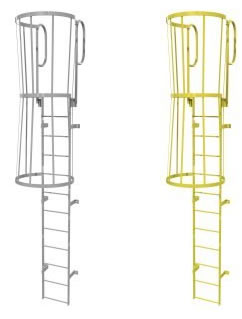 |
|
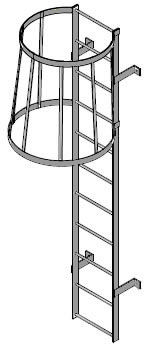 |
|
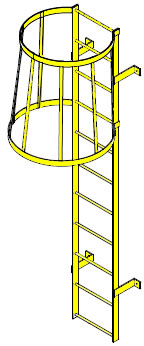 |
|
|
Standard
Ladders W/Cage
WLFC11 Series |
|
Walk-Thru
Ladders W/Cage
WLFC12 Series |
|
|
|
|
 |
|
Order
Online, by Phone, or by E-Mail |
|
|
|
~ Add
items to your online shopping cart ~
Click the Price of the item you wish to purchase. |
|
|
PRICING
FOR FIXED STEEL WALK-THRU LADDERS WITH CAGE
(Click
the Model No. for Drawing Dimensions) |
Powder-Coat
Gray Finish |
Safety
Yellow |
Weight
(lbs) |
#
of
Rungs |
Length
top
to Bottom
Rung |
Model
No. |
Price |
Model
No. |
Price |
|
|
|
|
241 |
11 |
10' |
|
|
|
|
262 |
12 |
11' |
|
|
|
|
282 |
13 |
12' |
|
|
|
|
299 |
14 |
13' |
|
|
|
|
313 |
15 |
14' |
|
|
|
|
338 |
16 |
15' |
|
|
|
|
357 |
17 |
16' |
|
|
|
|
377 |
18 |
17' |
|
|
|
|
385 |
19 |
18' |
|
|
|
|
407 |
20 |
19' |
|
|
|
|
427 |
21 |
20' |
|
|
|
|
445 |
22 |
21' |
|
|
|
|
460 |
23 |
22' |
|
|
|
|
481 |
24 |
23' |
|
|
|
|
501 |
25 |
24' |
|
|
|
|
521 |
26 |
25' |
|
|
|
|
547 |
27 |
26' |
|
|
|
|
567 |
28 |
27' |
|
|
|
|
587 |
29 |
28' |
|
|
|
|
607 |
30 |
29' |
|
|
PRICING
FOR FIXED STEEL STANDARD LADDERS WITH CAGE
(Click
the Model No. for Drawing Dimensions) |
Powder-Coat
Gray Finish |
Safety
Yellow |
Weight
(lbs) |
#
of
Rungs |
Length
top
to Bottom
Rung |
Model
No. |
Price |
Model
No. |
Price |
|
|
|
|
202 |
11 |
10' |
|
|
|
|
223 |
12 |
11' |
|
|
|
|
243 |
13 |
12' |
|
|
|
|
260 |
14 |
13' |
|
|
|
|
274 |
15 |
14' |
|
|
|
|
299 |
16 |
15' |
|
|
|
|
318 |
17 |
16' |
|
|
|
|
338 |
18 |
17' |
|
|
|
|
346 |
19 |
18' |
|
|
|
|
368 |
20 |
19' |
|
|
|
|
399 |
21 |
20' |
|
|
|
|
406 |
22 |
21' |
|
|
|
|
421 |
23 |
22' |
|
|
|
|
442 |
24 |
23' |
|
|
|
|
462 |
25 |
24' |
|
|
|
|
482 |
26 |
25' |
|
|
|
|
508 |
27 |
26' |
|
|
|
|
528 |
28 |
27' |
|
|
|
|
548 |
29 |
28' |
|
|
|
|
568 |
30 |
29' |
|
|
FIXED
LADDER DOOR GUARD INSTALLATION GUIDE |
| OPFS03
DOOR GUARD .............................................................................................................................. $500.40 |
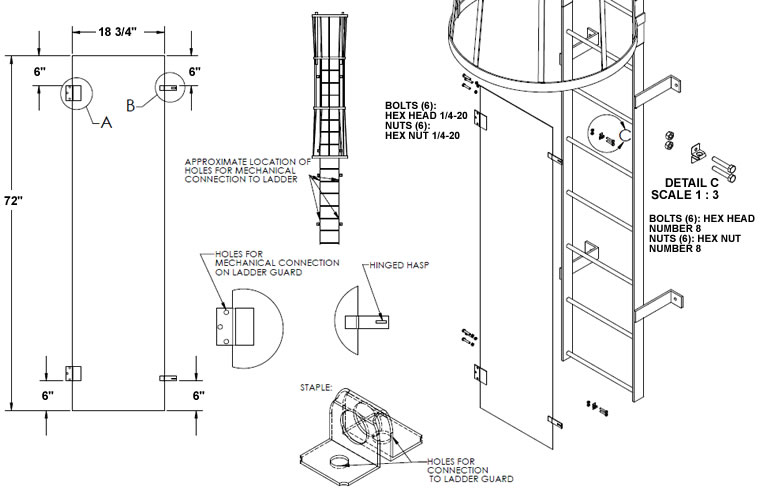 |
| DIRECTIONS |
1.CLAMP
GUARD TO LADDER
2.USING EXISTING HINGES HOLES, MARK LADDER FOR DRILLING
3.REMOVE GUARD AND DRILL HOLES
4.MOUNT GUARD WITH SIX 1/4-20 HEX HEAD BOLTS
5.CLOSE GUARD OVER LADDER
6.USE THE CLOSED HASPS TO ASSIST IN LOCATING AND MARKING THE HOLES
TO MOUNT THE STAPLES
7.MOUNT STAPLES USING SIXNUMBER 8 HEX HEAD BOLTS
8. THE LADDER IS NOW READY FOR USE |
|
WLFS
MOUNTING TABLE |
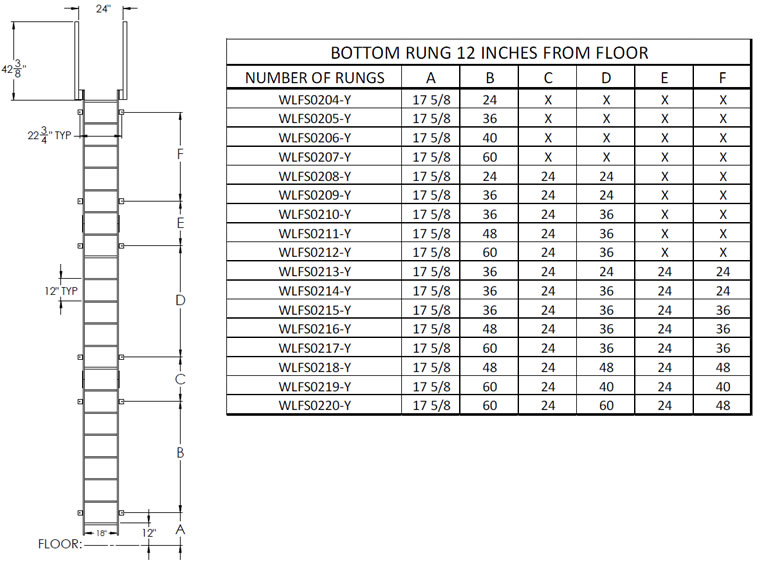 |
|
STEEL
FIXED LADDERS REQUIREMENTS |
|
|
Fixed
ladders are the subject of strict guidelines from OSHA and ANSI, the two
organizations most responsible
for setting and maintaining safety standards in the United States. Some
of the regulations are difficult to navigate,
and some have recently changed. |
|
|
What
are fixed ladders?
Fixed ladders, as defined by OSHA, 29 CFR 1910.21, are ladders “with
rails or individual rungs that (are) permanently
attached to a structure, building or equipment.” These ladders provide
access to places ranging from the rooftop of an
office or apartment building to the highest levels of a warehouse, or down
to the waterline from a boat dock or to an
underground site. |
|
|
| OSHA
and ANSI standards for fixed ladders |
|
|
OSHA,
the federal government’s Occupational Safety and Health Administration,
and ANSI, the nonprofit
American National Standards Institute, have set down detailed regulations
on the construction and use of fixed ladders. |
|
|
| They
include detailed instructions on, to name a few things: |
|
|
|
• The spacing
of rungs.
• The width between side members, which are the vertical railings on
each side of the ladder.
• The length of stand-off brackets. These are the fixtures that attach
the ladder to a wall and establish the distance
between the ladder and the building.
• The degree of pitch, the angle between the vertical wall and the
leaning ladder. The ideal pitch of a fixed ladder
is 75 degrees to 90 degrees from the horizontal.
• The height that side rails should extend beyond the landing surface,
such as the roof.
• The load amount allowed per ladder.
• The placement of grab bars. |
|
|
OSHA
and ANSI standards for vertical fixed access ladders cover many other issues,
including clearance, rest
platforms and clear width. And the regulators sometimes update the rules.
A major change in safety standards
for fixed ladders occurred several years ago. |
|
| Fixed
ladder requirements have changed |
|
Previously,
fixed ladders longer than 24 feet were required to have either cages or
wells to help ensure the safety
of the people climbing them. |
|
The
value of cages and wells was questioned, however, and on Jan. 17, 2018,
the regulations changed. Cages
and wells were being phased out, except in certain grandfathered-in cases,
and personal fall arrest systems (PFAS)
and ladder safety systems (LSS) were being phased in for ladders of 24 feet
or more. |
|
By
Nov. 18, 2036, grandfathered-in or not, “All fixed ladders must be
equipped with a ladder safety or personal
fall arrest system.” |
|
| What
safety measures apply to fixed ladders? |
|
Let’s
take a look at the differences between different types of fall protection:
cages, wells, personal fall arrest
systems (PFAS) and ladder safety systems (LSS). |
|
Cages
and wells
OSHA calls a cage a type of basket guard “enclosing or nearly enclosing
a ladder’s climbing space and fastened
to one or both of the ladder’s side rails or to another structure.” |
|
Basically, a cage is affixed
to a ladder’s side rails and does not always provide 360-degree coverage.
A well is
“a permanent complete enclosure around a fixed ladder,” or a
permanent cage that provides 360-degree coverage. |
|
Both cages and wells prevent
people from making big, unintentional lateral movements, or movements
back and
away from a ladder. |
|
However,
the biggest danger in ladder accidents comes from the fall. Once someone
starts falling, he can get
seriously injured by hitting sections of the cage or well, and also become
entangled in them. |
|
| Personal
fall arrest system |
|
PFAS
and LSS are designed to stop someone’s fall quickly and safely. A PFAS
(which most people have seen in
any movie showing a window washer on the side of a high-rise building) is
composed of a harness tethered to an
anchor secure enough to withstand the weight of someone falling. Instead
of crashing to the ground or hitting sections
of a cage or well, the person would be suspended briefly until he can regain
his footing. |
|
| Ladder
safety system |
|
An
LSS is similar to a PFAS in that a harness is worn. However, the harness
is hooked to a pulley system embedded
into or attached to the side of the ladder. This system kicks into action
only when a fall occurs, similar to the way a
car’s seatbelt works only during a sudden stop. |
|
Again,
by Nov. 18, 2036, all fixed ladders longer than 24 feet will be required
to be equipped with either a PFSA
or a LSS. |
|
Steel
is much heavier than aluminum, which means that steel ladders are much more
durable and resilient. However,
steel rusts over time unless treated with an anti-rust agent. Our paint
system for its fixed steel ladders ensures a top-
notch finish. And its all-welded production and “state-of the-art robotic
weld cell” minimize rust to a non-issue. |
|
A vertical fixed access ladder
also should allow easy access to the climber’s destination, be it
a rooftop or a dock.
Thus, proper walk-thru handrails, or the part of the ladder through which
one passes to step on a rooftop or dock,
are vital. The walk-thru rails of our fixed ladders are designed for easy
access and egress. |
|
The
texture of the rungs is another major issue. Rungs should grip shoes instead
of encouraging Marx-Brother-type
pratfalls. Perforated steel treads are kind of like the old-school cheese
graters with upward-facing holes and down-
ward-facing slots for gripping and for drainage. |
|
|
Fixed Steel Ladders, Fixed
Steel Walk-Thru Ladders, Fixed, Walk-Thru Handrails, Ships In Box, Stainless
Steel Construction, Fixed
Ladders with Safety Cages, Standoff Landing Platforms with Offset Caged
Ladders, Security Cage Entry Gate, and Security Ladder
Guard from your source for material handling equipment. |
Back to Product Category
|



